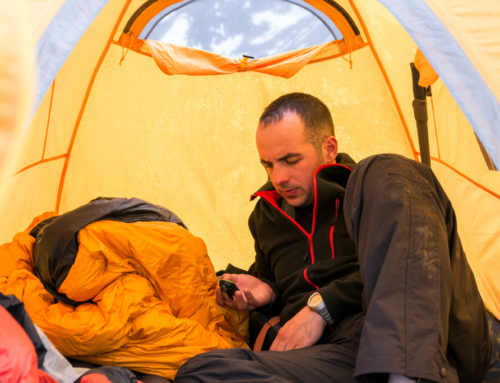As you get ready for your next adventure, take time to review these five simple steps to make sure you’re prepared for anything that comes your way.
1. Don’t Leave Home Without the Basics
- Water
- Sunscreen
- Insect Repellent
- Flashlight, with extra batteries
- Warm blanket
- Small votive type candle, empty tin can
- Lighter
- First aid kit including pain reliever and Benedryl
- Fire extinguisher
- Shovel
- Knife/multi-purpose tool
- Lantern
- Solar-powered cell phone charger
- Non-perishable staple foods (soups, canned pastas, chili, crackers, sports drinks, etc.)
- Ropes, tarps, bungee straps, tape and other items necessary to secure any gear
- Wood blocks and levelers to assist in leveling your recreational vehicle
2. Be sure to tell someone back home your plans
Before you leave on your trip, always tell a family member or someone else you trust what your plans are. Tell them where you are going, who you are going with and what time you will be returning. If you happen to change your plans, be sure to call that person and let them know. This will give you the peace of mind of knowing that should you get stranded or run into another unexpected situation, your contact back home will make sure that help is on the way.
3. Learn some basic first aid and carry a first aid kit with you
Hopefully, you’ll never need it, but you’ll be glad you were prepared if you ever do. The American Red Cross recommends that a first aid kit for a family of four include the following:
- 2 absorbent compress dressings (5 x 9 inches)
- 25 adhesive bandages (assorted sizes)
- 1 adhesive cloth tape (10 yards x 1 inch)
- 5 antibiotic ointment packets (approximately 1 gram)
- 5 antiseptic wipe packets
- 2 packets of aspirin (81 mg each)
- 1 blanket (space blanket)
- 1 breathing barrier (with one-way valve)
- 1 instant cold compress
- 2 pair of nonlatex gloves (size: large)
- 2 hydrocortisone ointment packets (approximately 1 gram each)
- Scissors
- 1 roller bandage (3 inches wide)
- 1 roller bandage (4 inches wide)
- 5 sterile gauze pads (3 x 3 inches)
- 5 sterile gauze pads (4 x 4 inches)
- Oral thermometer (non-mercury/nonglass)
- 2 triangular bandages
- Tweezers
- First aid instruction booklet
4. Bring the proper clothing and equipment to deal with changing weather
Weather conditions can change in a heartbeat, so when you’re traveling across country and visiting different climates, you never know what kind of weather conditions you might encounter. It’s best to dress in layers so you can adjust your clothing as necessary as the weather changes throughout the day.
You should also plan for changing conditions by packing a variety of outer garments and footwear. With the following items on hand, you’ll be able to weather any storm:Sunglasses
- Rain jacket
- Fleece or wool pullover
- Hat
- Gloves
- Sturdy pair of walking shoes or hiking boots
5. Make sure your vehicle is “road ready”
Before you leave home, always perform a vehicle safety check to ensure that your vehicle and all your belongings are ready for the road:
- Make sure your tires are fully inflated and there’s no unusual tread wear
- Check and refill all your fluids including oil, coolant, brakes, transmission, power steering and washer fluid
- Test all of your lights, including headlights, taillights and brake lights
- Make sure anything you’re bringing with you is securely attached to your vehicle, including bikes, canoes, car toppers, lawn chairs and coolers
- If you are towing a vehicle or any type of trailer, make sure the hitching mechanism and all safety chains are securely attached and that the wiring harness and connections are appropriate and in good working order
Have a safe trip!





